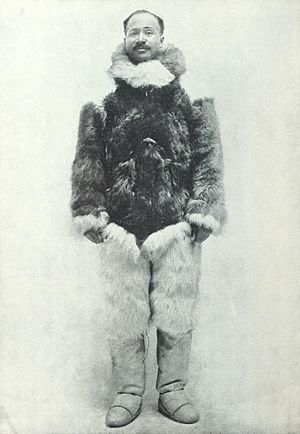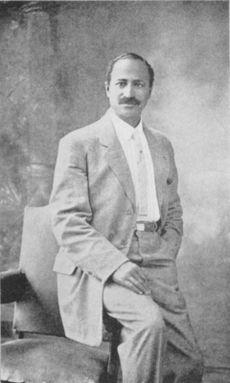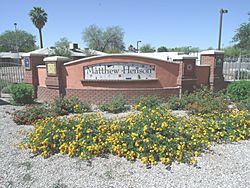Matthew Henson facts for kids
Quick facts for kids
Matthew A Henson
|
|
|---|---|
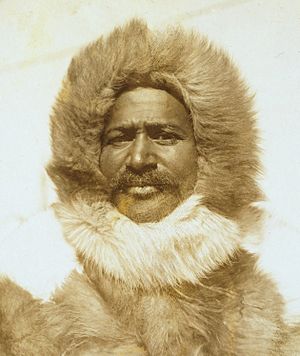
Henson around 1910
|
|
| Born |
Matthew Alexander Henson
August 8, 1866 Nanjemoy, Maryland, U.S.
|
| Died | March 9, 1955 (aged 88) The Bronx, New York, US
|
| Resting place | Arlington National Cemetery |
| Known for | Arctic explorer, claimed as the first to reach the geographic North Pole |
| Spouse(s) |
Eva Flint
(m. 1891–1897)Akatingwah |
| Children | Anauakaq (1906–1987; by Akatingwah) |
Matthew Alexander Henson (born August 8, 1866 – died March 9, 1955) was an American explorer. He is famous for his many trips to the Arctic with Robert Peary. They explored together for nearly 23 years. Matthew Henson is best known for being part of the 1908–1909 expedition. This team claimed to have reached the geographic North Pole on April 6, 1909. Henson himself said he was the first person in their group to reach the Pole.
Henson was born in Nanjemoy, Maryland. His parents were sharecroppers and free Black Americans. He spent his early years in Washington, D.C.. At age twelve, he left school to work as a cabin boy on a ship. Later, he worked in a department store. There, he met Robert Peary, who hired him in 1887. Peary was working on the Nicaragua Canal at the time.
Their first Arctic trip was in 1891–92. Henson was a navigator and a skilled craftsman. He was known as Peary's "first man." He learned many Inuit survival skills, just like Peary.
Contents
Early Life and Learning
Matthew Henson was born on August 8, 1866. His family lived on a farm in Charles County, Maryland. His parents were sharecroppers and had been free Black Americans before the American Civil War. After the war, Matthew's family faced challenges from groups like the Ku Klux Klan. These groups caused fear for many Black Americans.
To find safety, the Henson family moved to Georgetown in 1867. Georgetown was a town near Washington, D.C. Matthew's mother died when he was seven years old. His father remarried and had more children.
After his father passed away, Matthew lived with his uncle in Washington, D.C. His uncle paid for a few years of school. But his uncle also died soon after. Matthew went to a Black public school for six more years. During this time, he worked washing dishes in a restaurant. A special event happened when he was 10. He went to a ceremony for Abraham Lincoln. There, he heard a speech by Frederick Douglass. Douglass was a famous speaker and former slave. He encouraged Black people to get an education and fight against unfair treatment.
At age twelve, Matthew went to Baltimore, Maryland. This was a busy port city. He became a cabin boy on a merchant ship called Katie Hines. He traveled to many places, including China, Japan, Africa, and the Russian Arctic. The ship's captain, Captain Childs, taught Henson to read and write.
Exploring the Arctic
In November 1887, Henson was working in a clothing store in Washington, D.C. There, he met Commander Robert Peary. Peary learned about Henson's sea experience. He hired Henson to help him on a trip to Nicaragua. Peary was surveying for a canal there. Henson's skills on that trip impressed Peary. Peary then hired him as a main helper for his future expeditions.
For more than 20 years, their trips were to the Arctic. Henson became very good at trading with the Inuit people. He also learned to speak the Inuit language. The Inuit called him Mahri-Pahluk. He was known as the only non-Inuit person who was skilled at driving dog sleds. He also trained dog teams in the Inuit way. Henson was a clever craftsman. He often found ways to solve problems in the harsh Arctic weather. He and the team learned to build igloos from snow for shelter. Their teams traveled thousands of miles by dog sled. They reached the "Farthest North" point of any Arctic trip until 1909.
The North Pole Journey
In 1908–09, Peary tried for the eighth time to reach the North Pole. It was a very large expedition. Peary planned to set up supply points along the way. He and Henson left Greenland on August 18, 1909, on their ship Roosevelt. They had with them:
22 Inuit men, 17 Inuit women, 10 children, 246 dogs, 70 tons (64 metric tons) of whale meat, and tons of coal. In February, Henson and Peary left their ship at Ellesmere Island. They had Inuit men and 130 dogs to create a path and carry supplies toward the Pole.
Peary chose Henson and four Inuit men for the final push to the Pole. This group of six men would try to reach the goal. Before they reached the Pole, Peary could no longer walk. He rode in a dog sled. Some stories say he was sick, tired, or had frozen toes. He sent Henson ahead to scout the way.
In a newspaper interview, Henson later said:
I was in the lead that had gone past the mark by a couple of miles. We went back then and I could see that my footprints were the first at the spot.
Henson then placed the American flag.
The claim by Peary's team to have reached the North Pole was debated. Another explorer, Frederick Cook, also claimed to have reached it. The National Geographic Society and the U.S. House of Representatives both said Peary's team reached the Pole. But others still had doubts. In 1988, explorer Wally Herbert looked at Peary's notes. He found them "lacking in important details." This brought back questions about Peary's claim.
Life After the Expeditions
In 1912, Henson wrote a book about his Arctic trips. It was called A Negro Explorer at the North Pole. In the book, he called himself a "general assistant, skilled craftsperson, interpreter, and laborer." He later worked with author Bradley Robinson on his 1947 book, Dark Companion. This book shared more about Henson's life.
For many years, Admiral Peary received many honors for the expedition. But Henson's important work was often overlooked. In 1909, he was honored at dinners within the Black community. Henson spent most of the next 30 years working at the U.S. Customs House in New York. This job was suggested by Theodore Roosevelt.
Later in his life, Henson started to get more attention. In 1937, he became a member of the famous Explorers Club in New York City. In 1948, he was made an honorary member. This is a very special honor given to only 20 living members each year. In 1944, Congress gave him and five other Peary helpers the Peary Polar Expedition Medal. This was a silver medal also given to Peary. Presidents Harry S. Truman and Dwight D. Eisenhower honored Henson before he died in 1955.
Henson died in the Bronx on March 9, 1955. He was 88 years old. He was buried at Woodlawn Cemetery with his wife Lucy. In 1988, both their bodies were moved to Arlington National Cemetery. A special ceremony was held to honor them.
His Family and Descendants
Henson married Eva Flint in 1891. But they divorced in 1897 because of their long times apart. He later married Lucy Ross in New York City on September 7, 1907. They did not have children together.
During the long trips to Greenland, Matthew Henson had a son named Anauakaq. Anauakaq was born in 1906. His mother was an Inuit woman named Akatingwah. Anauakaq's children are Henson's only direct descendants. After 1909, Henson never saw Akatingwah or his son again. Other explorers sometimes gave him updates about them. A French explorer named Jean Malaurie first shared that Henson and Peary had descendants. He spent a year in Greenland in 1951–52.
S. Allen Counter, a scientist, was interested in Henson's story. In 1986, he found Henson's son, Anauakaq, and Peary's son, Kali. Both men were in their eighties. Counter arranged for them to visit the United States in 1987. There, they met American relatives from both families. They also visited their fathers' graves. Anauakaq died in 1987. He and his wife Aviaq had five sons and a daughter. These children have their own families now. Some still live in Greenland, while others have moved to Sweden or the United States.
Several Inuit family members came to Washington, D.C., in 1988. They attended the ceremony when Henson and his wife Lucy were reburied at Arlington National Cemetery. Counter had asked President Ronald Reagan for this honor. He wanted Henson's contributions to Arctic exploration to be recognized. Counter wrote a book about finding Anauakaq and Kali. It was called North Pole Legacy: Black, White and Eskimo (1991). This story was also made into a film documentary.
Honors and Legacy
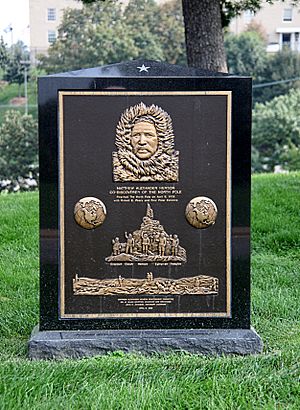
- On October 19, 1909, Henson was honored at a dinner in New York. He received a gold watch and chain.
- In 1937, The Explorers Club invited Henson to become a member.
- In 1940, a public housing project in Phoenix, Arizona, was named after Matthew Henson.
- In 1940, Henson was honored with one of 33 dioramas at the American Negro Exposition in Chicago.
- In 1945, Henson and other Peary helpers received U.S. Navy medals.
- In 1948, The Explorers Club gave Henson its highest honor: Honorary Member.
- In 1954, Henson was invited to the White House.
- Before he died in 1955, Henson received honorary degrees from Howard University and Morgan State University.
- On May 28, 1986, the United States Postal Service released a postage stamp honoring Henson and Peary.
- In 1988, Henson and his wife Lucy were reburied in Arlington National Cemetery. A monument was placed there to honor his explorations. Many of his Inuit descendants and American relatives attended.
- In October 1996, the United States Navy named a survey ship after him: USNS Henson (T-AGS 63).
- In 2000, the National Geographic Society gave the Hubbard Medal to Matthew A. Henson after his death. They also started a scholarship in his name.
- Places in Maryland named after Henson include Matthew Henson State Park, Matthew Henson Middle School, and elementary schools in Baltimore and Palmer Park.
- The Henson Glacier (Greenland) was named after him.
- In 2008-2009, an expedition to the North Pole was done by Dwayne Fields to honor Henson.
- In October 2020, a GPS Block III satellite was renamed Matthew Henson.
- In September 2021, a crater at the south pole of the Moon was named Henson after him.
Matthew Henson in Media
- "Matthew Henson, Black Explorer" was a filmstrip in "The Scooby-Doo Gang: Black Explorers" series in 1978.
- S. Allen Counter's book, North Pole Legacy: Black, White and Eskimo (1991), talks about the explorations. It also discusses Henson's descendants and race relations. He made a film documentary with the same name.
- The 1998 TV movie Glory & Honor was about Peary and Henson's explorations. Delroy Lindo played Henson, and Henry Czerny played Robert Peary.
- Henson's role in polar trips was in E. L. Doctorow's novel, Ragtime (1975).
- Donna Jo Napoli's young adult novel, North, is based on Henson's life.
- In 2012, German artist Simon Schwartz published a graphic novel about Henson called Packeis. It was published in English as First Man: Reimagining Matthew Henson in 2015.
- In the graphic novel Sous le soleil de minuit (2015), Henson helps Corto Maltese in his Alaskan adventure.
- Henson's story is featured in Kevin Hart's Guide to Black History on Netflix.
See also
 In Spanish: Matthew Henson para niños
In Spanish: Matthew Henson para niños


